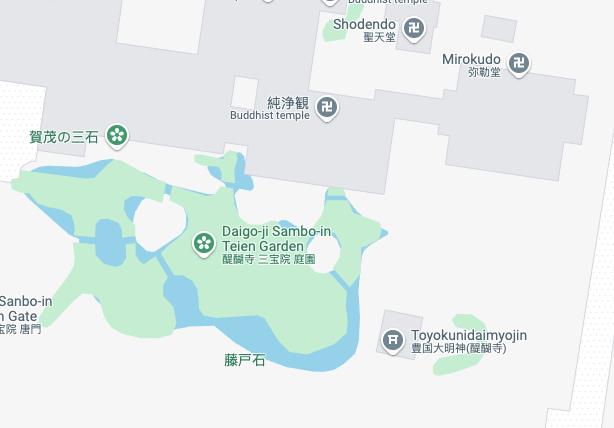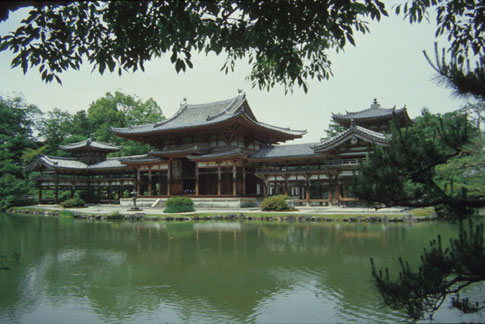
Sanpo-in (sometimes "Sambo-in" in English texts) is a subtemple of the Shingon temple of Daigo-ji, but its architecture and garden are more akin to the secular villas of the Heian nobility than to earlier Buddhist temples. Its current appearance is the result of a rebuilding initiated by Toyotomi Hideyoshi at the end of the 16th Century, and the stroll-and-pond garden was clearly designed to accommodate the lavish parties thrown by that ruler. Although its many bridges and its wealth of stones—it is said that over 700 rocks are incorporated in the design—have been criticized as running counter to the traditionally subtle and understated beauty of the best Japanese gardens, others have admired the imaginative treatment of its details and the dramatic sweep of it composition. Choose a view point from the map or click on Tour the Garden for more views of this garden. A more detailed history of the garden is reached by clicking on History.
The Sanpo-in (alternatively spelled "Sambo-in" in English texts) is a subtemple of the Shingon temple of Daigo-ji located on the steep slope of Mount Daigo in southeastern Kyoto. The origins of Daigo-ji are obscure, but it was certainly an active temple in the Heian Period and became even more important in the Muromachi Period. Except for its 10th-Century pagoda, the temple was destroyed in the wars of the 15th Century and was not restored until the close of the 16th Century. The principal supporter of that restoration was Toyotomi Hideyoshi, regent and chancelor to the Emperor but in reality the ruler of Japan in the last years of the Momoyama Period (had he not been born of peasant stock he would have been the Shogun of his day). Although the Sanpo-in was and is a temple, the structure and its garden were designed along the lines of a Heian villa, and the garden probably echoes on a smaller scale the lost gardens of Hideyoshi’s castles in Kyoto. As a place of recreation as well as worship, it is associated with Hideyoshi’s grandiose cherry blossom parties and other social events. Although it must be viewed today from the verandas of the two buildings that face it, it was intended as a stroll garden, which accounts for the number of bridges that give access to all the islands and peninsulas of the plan.
The design of the garden is attributed to Yoshiro (or Kentai, to give him his honorific title), but one assumes that Hideyoshi had a hand in its planning. From a critical point of view, the garden has been said to mirror the lavish tastes of the Shoguns and their daimyo, as has the Edo-Period garden at Nijo Castle. Surely few if any gardens of this size feature as many as 700 stones and eight bridges, leading many critics to see the result as crowded and incoherent. But the design has a broad sweep and a kind of reckless daring for which Hideyoshi was noted. It also mirrors the adventurous spirit of contemporary screen painting as practiced by artists like Tohaku and Sotatsu.

